Chichen Itza in 1995: Beyond the Castillo
Part 2: The Rest of the Great Northern Platform - Travel Tales from the Land of the Maya #9
Welcome back to another installment of Travel Tales from the Land of the Maya, stories!
If you are new here or haven’t read any of the earlier installments, this is the story of my first trip to the Yucatan Peninsula on my honeymoon in 1995. Today’s post is part two of our exploration of Chichen Itza. In the first part, I talked about our experiences in and around the Castillo.
Hope you are enjoying the stories!
As we entered the site, we were in the Great Northern Platform, dominated by the Pyramid of Kukulcan, also known as the Castillo. Standing in the center of it all, the symmetrical step-pyramid with four stairways was begging to be climbed.
We didn’t let it wait too long. Climbing the Castillo was the first thing we did. Not just because it was there, but we wanted to get the toughest climb out of the way while it was still cool enough, see the temple on top, and the views of the ancient city from the top.
After spending time on top and later inside it, we moved on to explore the rest of the site.
Though we only saw what remained of the ancient site, we could tell from the buildings that Chichen Itza was once an important city. In fact, it was one of the largest ancient Maya cities in the Yucatan area, from the Late Classic (600-900 AD) to the early Postclassic (900-1200 AD) period. At its height, between 900 and 1050 AD, it was a powerful regional capital controlling north and central Yucatan. As such a large city, it also had the most mixed population in the area.
The Maya name “Chichen Itza” means “At the mouth of the well of the Itza.” Although this is the accepted and used name for the site, according to the Chilam Balam1 books and some of the hieroglyphic texts at the site, the ancient city had an older name. Represented in several ways, it might have been Uuc Yabnal (Seven Great House), or Uucyabnal (Seven Great Rulers), among other variations.
The buildings of the ancient city are grouped in sets, each with different architectural styles, originally separated from each other by low walls. They include the Great North Platform, the Osario group, and the Southern Group. Besides these groups, the site also includes several cenotes (the largest and best known being the Sacred Cenote) and Old Chichen.
The Great Northern Platform features the most recent (and thus best-preserved) structures.
After descending the Castillo, we continued exploring the other structures in the Great Northern Platform, starting with the Temple of the Warriors.
The Temple of the Warriors
Standing west of the Castillo, a stepped pyramid surrounded by rows of square carved columns, the Temple of the Warriors was easier to climb. (Of course, its height might have had something to do with it, being much shorter than the Castillo.)
Before climbing it, though, we walked through the surrounding columns depicting warriors.
On top of the pyramid, leading toward the entrance of the temple, a Chac Mool2 figure surrounded by two serpent columns seemed to guard the entrance.
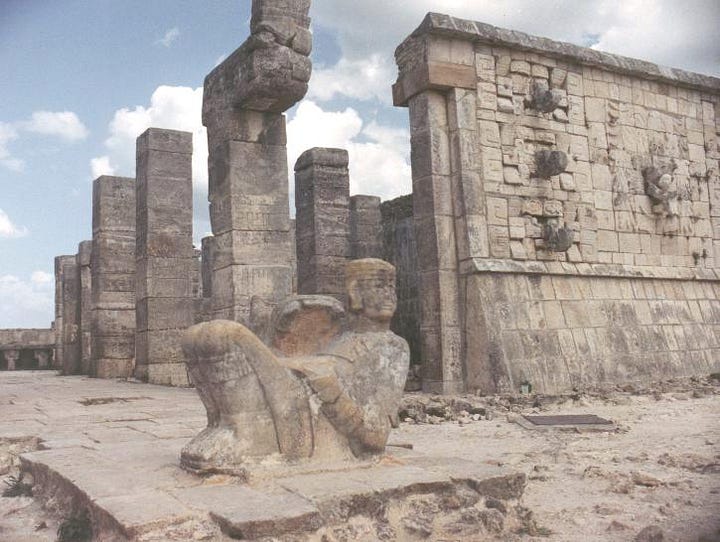
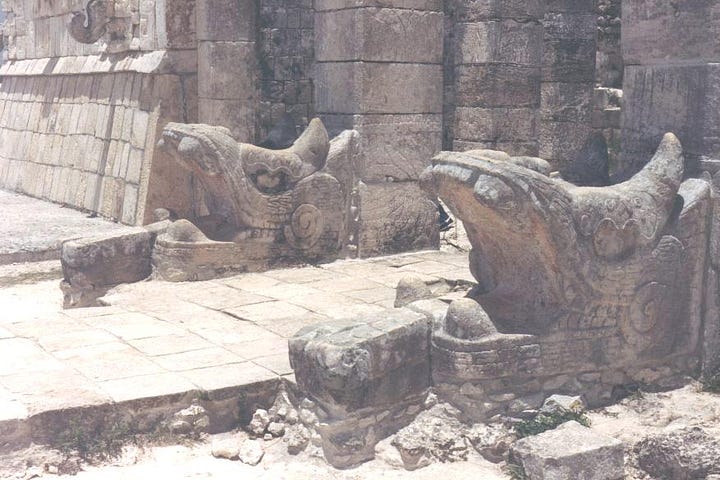
From the top of the Temple, we had a great view of the Castillo.
Although there is no way to see it, underneath the Temple of the Warriors, an older temple-pyramid is buried, called the Temple of Chak Mool. Archaeologists discovered it in the 1920s, when reconstructing the temple.
Group of a Thousand Columns
After descending the Temple of the Warriors, we wandered through the group of A Thousand Columns, along the south wall of the structure.
Exposed now, when built, the columns supported an extensive roof system. I doubt there are exactly a thousand of them (though I haven’t counted). Overall, it looks like a maze of carved columns, where, when we visited in later years, with our young children, they used to run around and play hide-and-seek.
Showcasing carvings in bas-relief, the columns are separated into three distinct sections. The west group extends the lines of the front of the Temple of Warriors. The north group runs along its south wall and contains pillars with carvings of soldiers in bas-relief.
The northeast group once formed a small temple at the southeast corner of the Temple of Warriors. The column temple on this side covers a channel that funnels the rainwater away from the complex, into a former cenote, about 40 meters (130 feet) away.
Two Platforms and A Tzompantli
Nearest the Castillo, across from its north side, sits the Venus Platform, dedicated to the planet Venus, an important celestial body for the ancient Maya.
A low, square platform with stairways leading to its top on all four sides, it was most likely used as a stage for ritual dances.
Behind it, a trail built on top of Sacbe Number One, the largest sacbe (white road) at Chichen Itza, measuring 9 meters (30 ft) wide and 270 meters (890 ft) long, leads to the Sacred Cenote.
Before taking the sacbe to the cenote, we walked towards the Great Ballcourt.
We stopped at another, smaller platform decorated with eagles and jaguars. Which would’ve been nice, except they are depicted as eating human hearts. Pretty gruesome, if you ask me, although it is hard to tell what they are doing. Called the Platform of Jaguars and Eagles, it stands in front of a Tzompantli, or skull rack.
Yes, you read it right: a skull rack. Historians and archaeologists tell us that these structures were used to display human skulls of enemies killed in battles and of sacrificial victims. Talk about more gruesome! I am happy I didn’t live there in ancient times to see them! At least this tzompantli is decorated with skulls carved in stone, not real ones, but still not one of my favorite structures.
The Great Ball Court and Its Temples
Northwest of the Castillo sits the Great Ball Court, our next destination. Measuring 168 by 70 meters (551 by 230 ft), it is the largest (making it the most famous) in all of ancient Mesoamerica.
Built into the east wall, visible from the top of the Castillo, are the Jaguar Temples, the Lower and Upper. The Lower Jaguar Temple opens to the Plaza, so it was the first one we entered.
I marveled at the elaborate bas-relief carvings on its walls and entrance columns, with some of the paint still showing on them. Inside the structure sits a jaguar throne similar to the one we saw in the belly of the Castillo, though this one, sitting in an open room, was much more worn.
The Upper Temple of the Jaguar stands on top of the massive wall and overlooks the ball court. Two large columns carved in the familiar feathered serpent motif guard its entrance. Inside, a large mural depicts a battle scene.
Two other temples stand at each end of the Ball Court.
The North Temple, also known as the Temple of the Bearded Man, is the smaller, but better preserved one. The small temple features detailed bas-relief carving on the inner walls, the carvings under the chin of the center figure resembling facial hair.
The temple on the south side is larger, but in ruins.
The ball court itself is enormous!
This was especially noticeable during our first visit, when only a few people were wandering through it. Still, we heard the now-famous claps when a guide demonstrated the acoustics in the giant ball court.
After the small group left, we were alone in the field, long enough to enjoy the solitude, imagining the ancient game played there.
It was the last time we saw the ball court empty.
Sometimes, when we visit a place, we don’t realize what a unique experience we have. We certainly didn’t think it was the last time we saw the ball court empty. Just like we didn’t think there would be a time we could not climb any of the structures, or that we’d never again be able to walk inside the Kukulcan pyramid. It was an important lesson we didn’t know we were learning at the time: enjoy a visit to any place you travel to, since the same moment would not repeat itself.
Before walking further in any direction, we found a spot overlooking the Castillo, where we sat under a tree, and had a snack lunch we brought, while watching people climb and descend the pyramid.
Later, we walked to the Cenote of Sacrifice, then to the South Group, and Old Chichen. But we spent more time exploring those areas the next day.
After leaving the site and having dinner in Piste, we returned to watch the light show at night. The seats were set up facing the Pyramid of Kukulcan (Castillo), in the center of the Great Northern Plaza we spent so much time during the day.
The light show was… well… kitchy and an experience we didn’t think we’d need to repeat. It was relatively short and static, though the colors illuminating the Castillo, and at times the Temple of the Warriors, were pretty nice.
We wished we could walk around at the site at night, with some of the structures illuminated. The new show is exactly what we wished for at the time. When we learned they changed it a few years ago, we went again and enjoyed it much more!
The Chilam Balam books are Maya handwritten books in Yucatec Mayan but using the Latin alphabet, preserving knowledge on history, prophecy, religion, ritual, literature, the calendar, astronomy, and medicine. They are attributed to an author called Chilam Balam (chilam means a priest who gives prophecies, and Balam a common surname meaning jaguar).
The first Chak Mool figure was found in Chichen Itza, buried under the Temple of the Eagles and Jaguars, in 1875. Augustus Le Plongeon, the explorer who found it, named it Chacmool, translating it from Yucatecan Mayan. In Chichen Itza alone, fourteen chakmool figures were found, but the statue is widespread throughout all of Mesoamerica. The oldest one discovered dates from the Postclassic period. They were used most likely as offering tables for gifts like pulque, tamales, tortillas, tobacco, turkeys, feathers, and incense. According to other interpretations, they were used as bowls for blood offerings, especially when used by the Aztecs. And, there is the most widespread idea (my least favorite one) that they were used as sacrificial stones where victims were stretched so their hearts would be cut out.
Thank you once again for reading my Travel Tales. Next time, I’ll tell you about the rest of the site, before moving on to other destinations.
In the meantime, wishing you all the best,
Emese
If you liked this post, you might enjoy:
previous issues of the Travel Tales from the Land of the Maya
You could also pick and choose from my posts about
If you enjoyed this post, please give it a “like” and share it to help others find it, too.
If you came across it on Substack and you are not a subscriber, consider subscribing.
And, if you’d like to support me in a small way, I always appreciate a cup of coffee.





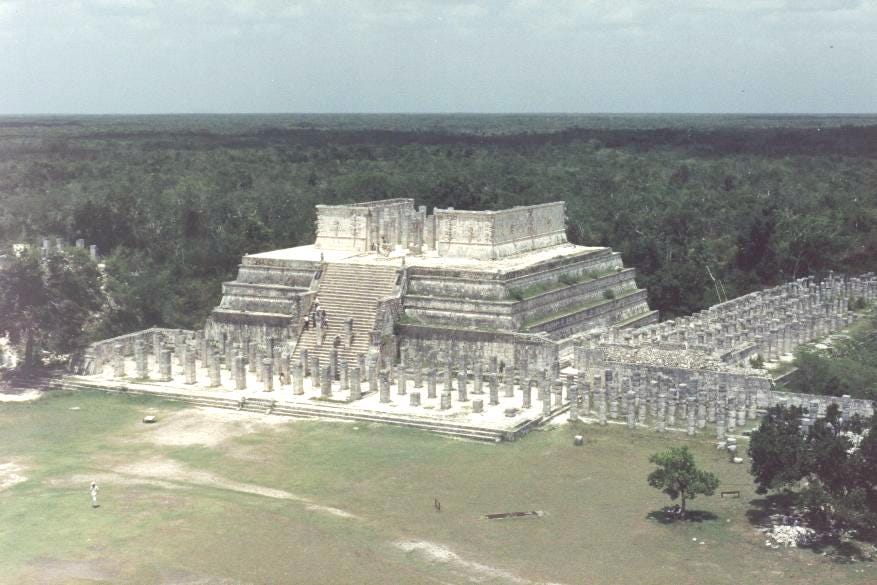
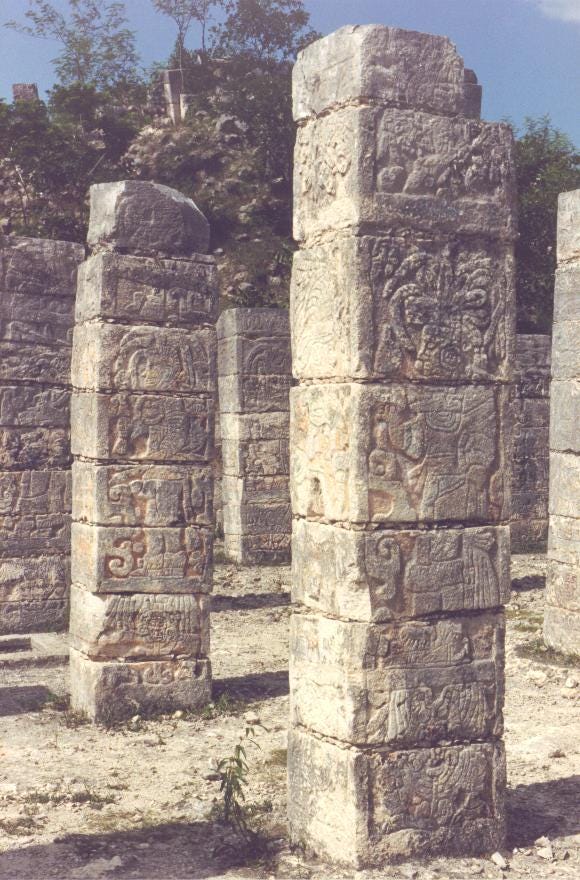

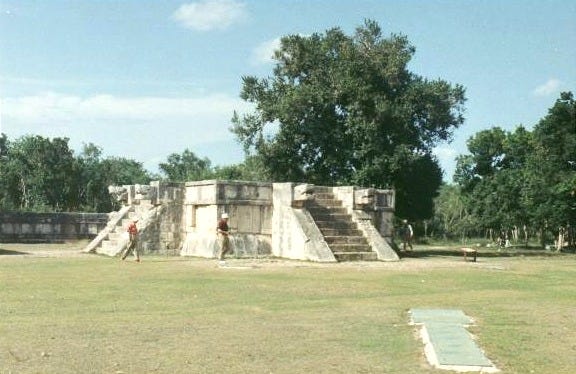
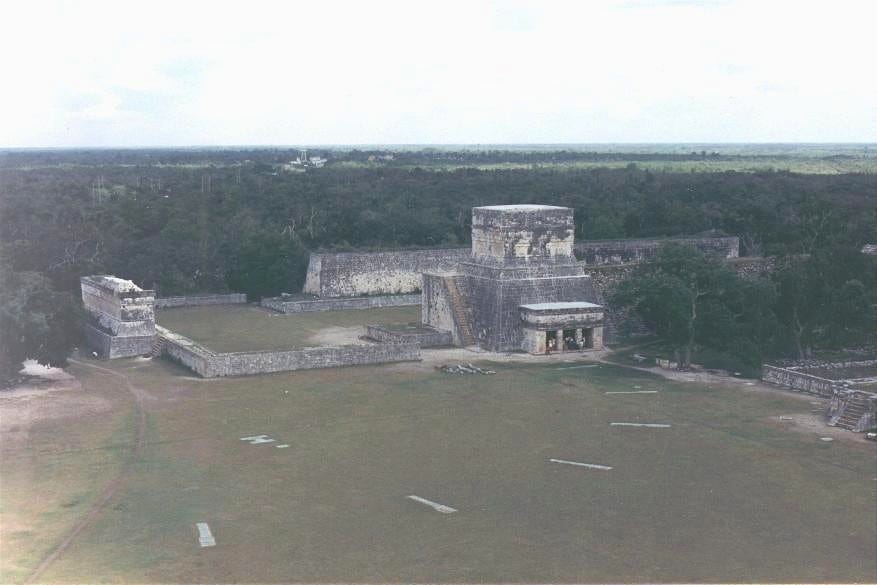
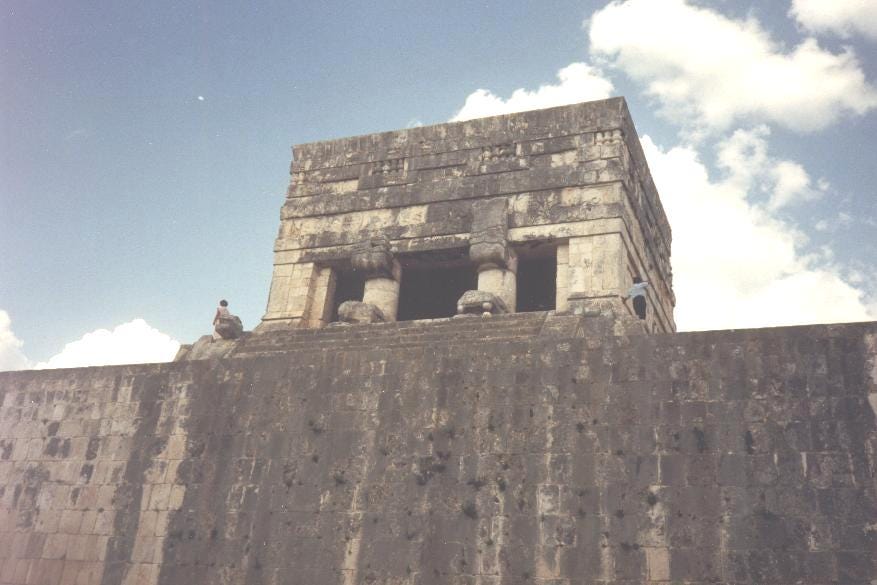
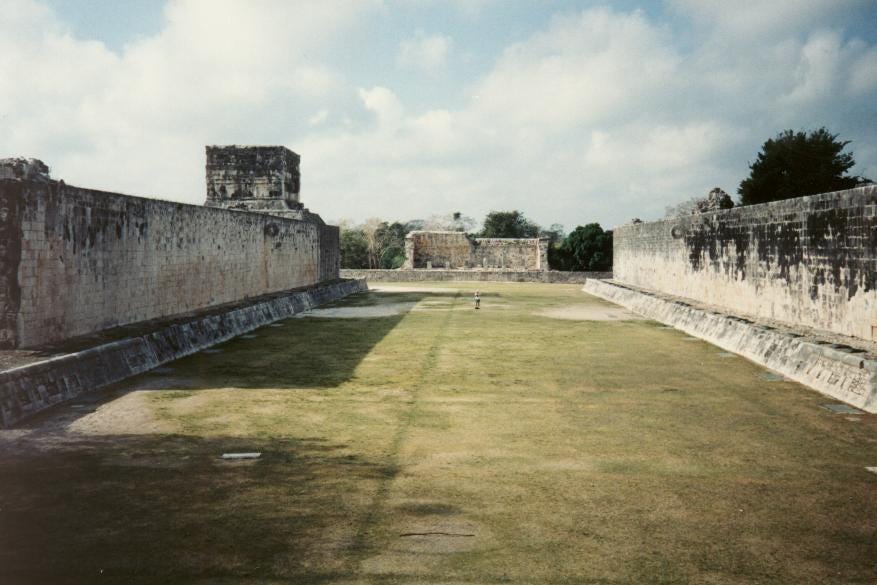


Always love to know more about the pyramids and you do such a great job of writing and explaining, Emese. I had no idea Chichen Itza had 2 previous names. I did know it had a couple or few iterations, also amazing. Like being raised from the dead. And being alone on the ball park, a wonderful feeling. And being at the top, El Castillo, when it could still be climbed. Love that photo where it's like you're looking over the shoulder of ChacMool! And odd as usual, how our posts intertwine, amiga, my June 13 post is on Alice Dixon Le Plongeon and her husband -- and their trip-explorations at Uxmal and drum roll, Chichen Itza and their discovery of ChacMool! We are synchronized somehow-could be our love of Yuc, PM and pyramids.